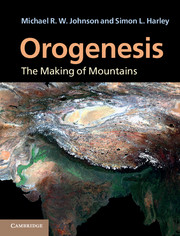Book contents
- Frontmatter
- Contents
- Preface
- Acknowledgments
- Geological timescale
- 1 Major features of the Earth and plate tectonics
- 2 Driving mechanisms for plates, slab retreat and advance, and a cause of orogenesis
- 3 Physical and chemical principles: rock deformation, isostasy, geochronology and heat production in the lithosphere
- 4 Large-scale features of orogens: thrusts and folds
- 5 Evolution of orogens
- 6 Lateral spreading of orogens: foreland propagation, channel flow and weak zones in the crust
- 7 Metamorphism in orogeny
- 8 The erosion and exhumation of mountains
- 9 Sedimentary history of the foredeep basins
- 10 Deep structure, mountain support and phase changes
- 11 Mountains and climate
- 12 Secular change in orogeny
- References
- Index
- Plate section
- References
10 - Deep structure, mountain support and phase changes
Published online by Cambridge University Press: 05 June 2012
- Frontmatter
- Contents
- Preface
- Acknowledgments
- Geological timescale
- 1 Major features of the Earth and plate tectonics
- 2 Driving mechanisms for plates, slab retreat and advance, and a cause of orogenesis
- 3 Physical and chemical principles: rock deformation, isostasy, geochronology and heat production in the lithosphere
- 4 Large-scale features of orogens: thrusts and folds
- 5 Evolution of orogens
- 6 Lateral spreading of orogens: foreland propagation, channel flow and weak zones in the crust
- 7 Metamorphism in orogeny
- 8 The erosion and exhumation of mountains
- 9 Sedimentary history of the foredeep basins
- 10 Deep structure, mountain support and phase changes
- 11 Mountains and climate
- 12 Secular change in orogeny
- References
- Index
- Plate section
- References
Summary
This chapter addresses the question of mountain support, isostasy and the tectonometamorphic and rheological processes operating in the deep structure of mountains that greatly influence their evolution. Referring to the outer part of the Earth, Barrell (1914) coined the terms lithosphere, the rocky part, and asthenosphere, the weaker lower part. This perceptive observation together with the concept of isostasy forms the basis for most of our thinking about mountains and their support. Clearly the mass of a mountain range or high plateau standing high above sea level requires a mechanism for its support. The creation of an elevated terrane means that work is done against gravity. The Tibetan Plateau could not stand at its present height without the support of a horizontal deviatoric stress, in this case the continuing plate convergence between India and Eurasia. Removal of this support would mean that the plateau would flow away – this is called orogenic collapse. It has been pointed out that the paradox in the Himalaya–Tibet example is that although the plate convergence continues steadily and the horizontal stress is maintained, the plateau is undergoing normal faulting which for many scientists implies that it is collapsing. This observation led to the idea that the lower part of the mantle lithosphere below Tibet has been delaminated and hence the Tibetan lithosphere acquired buoyancy.
Before going into the details of the geophysics of orogens it is necessary to consider models which show strength profiles through the lithosphere. There is ongoing debate between the ‘jelly sandwich’ model for the lithospheric rheology and the newer ‘crème brûlée’ model (Fig. 10.1). The jelly sandwich model is well established and might be regarded as the standard model for the rheology of the lithosphere; it is so called because it postulates a strong upper crust and upper mantle and a weak lower crust, whereas the more recent crème brûlée model, as proposed by Jackson (2002) and others, invokes a strong upper layer made up of the entire crust above a weak mantle.
- Type
- Chapter
- Information
- OrogenesisThe Making of Mountains, pp. 288 - 303Publisher: Cambridge University PressPrint publication year: 2012



